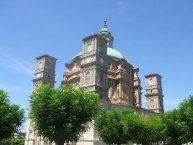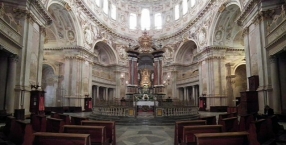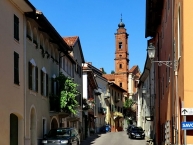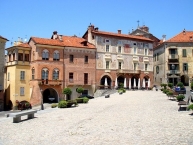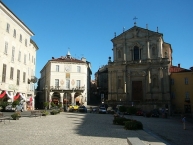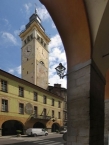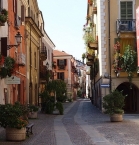Pedemontana Alpina Cycle Route
No. of cycle route BI12
Actions
![]()
Please wait - map data are loading
Added on 29 Jun 2014,
last edited by biroto-Redaktion on 19 Oct 2023
Actions
Cycle route metrics
Total distance in km
950
Information about rights to the gps-track data | |
|---|---|
Rights owner | OpenStreetMap and Contributors + biroto-Redaktion (biroto.eu) |
Rights characteristic / license | Contains information from OpenStreetMap, which is made available here under the Open Database License(ODbL) |
Link to the description of the license | |
GPX file taken from | |
GPX file uploaded | by biroto-Redaktion on 19 Oct 2023
|
Track points in total
19.199
Track points per km (avg)
20
Start/endpoint
Start location
Savona, 42, IT (16 m NHN)
End location
Volpago del Montello, 34, IT (108 m NHN)
Beds4Cyclists, worth visiting and infrastructure
Name and address
Latitude / Longitude
Phone
Fax
Mobile
Type of accommodation
Rating for cyclists
Route km
Dist. to route
Elevation
83 km
0,1 km
512 m
Information about copyright | |
|---|---|
Rights owner | |
Rights characteristic / license | by-sa: CREATIVE COMMONS Attribution-ShareAlike |
Link to the description of the license | |
Image taken over from | |
Image has been uploaded | by biroto-Redaktion on 25 Dec 2017
|
Information about copyright | |
|---|---|
Rights owner | |
Rights characteristic / license | by-sa: CREATIVE COMMONS Attribution-ShareAlike |
Link to the description of the license | |
Image taken over from | |
Image has been uploaded | by biroto-Redaktion on 25 Dec 2017
|
Information about copyright | |
|---|---|
Rights owner | |
Rights characteristic / license | by-sa: CREATIVE COMMONS Attribution-ShareAlike |
Link to the description of the license | |
Image taken over from | |
Image has been uploaded | by biroto-Redaktion on 25 Dec 2017
|
Vicoforte is a comune in the Province of Cuneo in Italy. It is located in Val Corsaglia at 547 metres (1,795 ft) above sea level, 32 kilometres (20 mi) east of Cuneo and 6 kilometres (3.7 mi) from Mondovì
.
See
The Santuario di Vicoforte (also known as Santuario Regina Montis Regalis) is a monumental church located in the commune of Vicoforte , province of Cuneo, Piedmont, northern Italy. It is known for having the largest elliptical cupola in the world.
History
It originated as a small medieval sanctuary, consisting of a modest shrine containing a fifteenth-century fresco depicting a Madonna and Child. Around 1590 a shooting party passed by and a huntsman accidentally struck the image of the Virgin. According to legend, she began to bleed. The penitent huntsman added his arquebus to the shrine and began to collect the large sum of money which would be needed to repair the damage and expiate his sin. Today the arquebus is preserved in a chapel of the sanctuary near the fresco which it had disfigured.
In time the place became a centre of pilgrimage. An early visitor was the duke Charles Emmanuel I of Savoy who, in 1596, commissioned the construction of a large sanctuary from the court architect Ascanio Vitozzi. However the death of both the duke (who had wanted to be buried here), and of the architect, put a stop to the building work.
Construction was resumed in the eighteenth century under Francesco Gallo who built the great elliptical cupola which has major and minor diameters of 36 and 25 metres (118 and 82 ft) respectively. It is said that Gallo was required to remove the scaffolding himself, as nobody thought that a structure of this type would be able to stand on its own.
The decoration in fresco of the 6,032 square metres (64,930 sq ft) of the cupola’s vault was completed in 1752 by Mattia Bortoloni and Felice Biella, and the sanctuary finally attained its current form in 1884, when the campanili were built along with the three façades.
On December 15, 2017, after years of planning, the remains of Queen Elena of Savoy, were secretly transferred from Montpellier, France, to the chapel of San Bernardo inside the sanctuary. Two days later, the remains of King Vittorio Emanuele III of Savoy were transferred from Alexandria, Egypt, where he had died in exile, and interred alongside the former queen.
Information about copyright | |
|---|---|
Rights characteristic / license | by-sa: CREATIVE COMMONS Attribution-ShareAlike |
Link to the description of the license | |
Input taken over from: |
|
taken over / edited on | 25 Dec 2017
|
taken over / edited by |
|
90 km
0,5 km
496 m
91 km
0,1 km
414 m
Information about copyright | |
|---|---|
Rights owner | https://commons.wikimedia.org/w/index.php?title=User:Girafrittata |
Rights characteristic / license | by-sa: CREATIVE COMMONS Attribution-ShareAlike |
Link to the description of the license | |
Image taken over from | https://commons.wikimedia.org/wiki/File:Mondovi_Piazza_-_18.jpg |
Image has been uploaded | by biroto-Redaktion on 25 Dec 2017
|
Information about copyright | |
|---|---|
Rights owner | |
Rights characteristic / license | by-sa: CREATIVE COMMONS Attribution-ShareAlike |
Link to the description of the license | |
Image taken over from | https://commons.wikimedia.org/wiki/File:Mondovì-TorreCivica.jpg |
Image has been uploaded | by biroto-Redaktion on 25 Dec 2017
|
Information about copyright | |
|---|---|
Rights owner | |
Rights characteristic / license | by-sa: CREATIVE COMMONS Attribution-ShareAlike |
Link to the description of the license | |
Image taken over from | https://commons.wikimedia.org/wiki/File:Mondovì-Cattedrale.jpg |
Image has been uploaded | by biroto-Redaktion on 25 Dec 2017
|
Information about copyright | |
|---|---|
Rights owner | |
Rights characteristic / license | by-sa: CREATIVE COMMONS Attribution-ShareAlike |
Link to the description of the license | |
Image taken over from | https://commons.wikimedia.org/wiki/File:Mondovì_-_Chiesa_San_Francesco_Saverio.jpg |
Image has been uploaded | by biroto-Redaktion on 25 Dec 2017
|
Mondovì (Italian pronunciation: [mondoˈvi]; Piemontese: Ël Mondvì [əl mʊndˈvi], Latin: Mons Regalis) is a town and comune (township) in Piedmont, northern Italy. The area around it is known as the Monregalese.
The town, located on the Monte Regale hill, is divided into several rioni (ancient quarters): Piazza (the most ancient), Breo, Pian della Valle, Carassone, Altipiano, Borgato and Rinchiuso, lower, next to the Ellero stream, developed from the 18th century when industries developed in Mondovì and when it was reached by the railway.
The Funicolare di Mondovì , a recently reopened funicular railway in the town, links Breo with Piazza.
It is the seat of the Roman Catholic Diocese of Mondovì. It is also the home of the Academia Montis Regalis orchestra led by conductor Alessandro De Marchi.
History
Founded on a hilltop in 1198 by survivors of the destroyed village of Bredolo and by inhabitants of the neighboring villages of Vico (now Vicoforte ), Vasco (now Monastero di Vasco) and Carassone (which was abandoned after the founding of the new city): an independent comune named Ël Mont ëd Vi, meaning "The Mount of Vico" in Piedmontese, was formed.
Their independence proved to be short-lived because the bishop of Asti and the marquis of Ceva stormed it in 1200 and destroyed it in 1231. The commune resisted, however, and the following year it was able to sustain another attack from Asti . In 1260 it was occupied by Charles I of Anjou (then King of Naples and one of the most powerful landlords in Provence and north-western Italy), while in 1274 it returned under the bishops of Asti. In 1290 he was however able to buy back its communal independence, under the new name of Mons Regalis ("Royal Mount") due to its large privileges. In 1305 it fell again under the Angevins, followed by the Visconti, the Marquisate of Montferrat, the Acaja and, from 1418, the House of Savoy.
Mondovì continued to grow until the 16th century when it was the largest city in Piedmont. In 1537 it was occupied by France, under which it mostly remained until 1559. In 1560, Emmanuel Philibert, Duke of Savoy restored it to Piedmont, which held it until the Italian unification, apart from the Napoleonic period (1796–1814).
Piedmont's first printing press was created in Mondovì in 1472. From 1560 to 1566, Mondovì was the seat of Piedmont's first university.
Main sights
- Church of San Francesco Saverio (1664–1678)
- Cathedral of San Donato
- Santa Croce Chapel, with a Gothic fresco cycle.
- Medieval walls and towers (12th century)
- Piazza Maggiore (Main Square, 14th-16th century), in Gothic style.
- Church of Santa Chiara
- Church of the Misericordia (1708–1717)
- Convent of Nostra Donna
- Palazzo Fauzone
- Chapel of San Rocco delle Carceri
- Chapel of San Borgato delle Forche, with notable Gothic paintings.
Information about copyright | |
|---|---|
Rights characteristic / license | by-sa: CREATIVE COMMONS Attribution-ShareAlike |
Link to the description of the license | |
Input taken over from: |
Wikipedia contributors, 'Mondovì', Wikipedia, The Free Encyclopedia, 25 November 2017, 11:41 UTC, <https://en.wikipedia.org/w/index.php?title=Mondov%C3%AC&oldid=812011208> [accessed 25 December 2017] |
taken over / edited on | 25 Dec 2017
|
taken over / edited by |
|
124 km
0,3 km
553 m
Hours of opening
- Mon–Fri: 8.30a.m.-1.00p.m. / 2.30-6.00p.m.
- Sat: 10.00a.m.-12.30p.m. / 2.30-6.00p.m. (from April to October), 10.00a.m.-1.00p.m. / 2.00p.m.-5.00p.m. (from November to March).
124 km
0,1 km
544 m
Information about copyright | |
|---|---|
Rights owner | |
Rights characteristic / license | by-sa: CREATIVE COMMONS Attribution-ShareAlike |
Link to the description of the license | |
Image taken over from | commons.wikimedia.org/wiki/File:Cuneo_Piazza_Galimberti.jpeg |
Image has been uploaded | by biroto-Redaktion on 07 Dec 2014
|
Information about copyright | |
|---|---|
Rights owner | |
Rights characteristic / license | by-sa: CREATIVE COMMONS Attribution-ShareAlike |
Link to the description of the license | |
Image taken over from | |
Image has been uploaded | by biroto-Redaktion on 07 Dec 2014
|
Information about copyright | |
|---|---|
Rights owner | Gian Francesco Fanti |
Rights characteristic / license | by-sa: CREATIVE COMMONS Attribution-ShareAlike |
Link to the description of the license | |
Image taken over from | |
Image has been uploaded | by biroto-Redaktion on 07 Dec 2014
|
Cuneo (Coni in Piedmontese) is a city and comune in Piedmont, Northern Italy, the capital of the province of Cuneo.
Cuneo became an important stronghold of the expanding Savoy state, and was thus besieged by France several times: first in 1515 by Swiss troops of Francis I of France, then again in 1542, 1557, 1639, 1641, 1691 and, during the War of Austrian Succession, in 1741. In all the sieges Cuneo resisted successfully. Cuneo was conquered by France only during the Napoleonic Wars, when it was made the capital of the Stura department. After the restoration of the Kingdom of Sardinia, and the unification of Italy, Cuneo became the capital of its namesake province in 1859.
Main sights
- Villa Oldofredi Tadini, built in the 14th and 15th centuries as a watchtower. It is now a museum housing collections of the owners, the Mocchia and Oldofredi Tadini families.
- Villa Tornaforte, surrounded by an English-style park.
- Civic Museum
- Railway Museum
- Churches of Santa Croce, San Giovanni Decollato and Santissima Annunziata, housing paintings by Giovan Francesco Gaggini.
- Panoramic funicolar that connects plateau to Gesso river.
- Monument of Stura and Gesso in Torino Square
- The median way of the plateau (Rome Avenue, Galimberti Square and Nice Avenue): the commercial heart of Cuneo.
- Nuvolari Libera Tribù: the longest summer's musical festival, near river Gesso
- Monument at Peano's curve
- Palazzo Uffici Finanziari (PUF), highest edifice in the city at about 50 metres (160 ft)
Information about copyright | |
|---|---|
Rights characteristic / license | by-sa: CREATIVE COMMONS Attribution-ShareAlike |
Link to the description of the license | |
Input taken over from: |
Wikipedia contributors, 'Cuneo', Wikipedia, The Free Encyclopedia, 31 October 2014, 07:55 UTC, <http://en.wikipedia.org/w/index.php?title=Cuneo&oldid=631861501> [accessed 7 December 2014] |
taken over / edited on | 07 Dec 2014
|
taken over / edited by |
|
![]()

